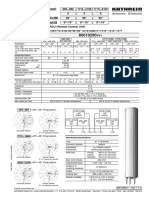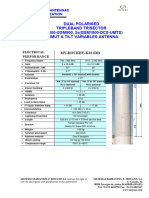80010292
80010292
Uploaded by
Anonymous ZYBA1RCopyright:
Available Formats
80010292
80010292
Uploaded by
Anonymous ZYBA1ROriginal Description:
Copyright
Available Formats
Share this document
Did you find this document useful?
Is this content inappropriate?
Copyright:
Available Formats
80010292
80010292
Uploaded by
Anonymous ZYBA1RCopyright:
Available Formats
Triple-multiband Panel 790 960 1710 2180 1710 2180
Dual Polarization X X X
Half-power Beam Width 65 65 65
Adjust. Electr. Downtilt 210 010 010
set by hand or by optional RCU (Remote Control Unit)
XXXPol Panel 790960/17102180/17102180 65/65/65 17.5/17.5/17dBi 210/010/010T
Type No. 80010292V03
790 960 1710 2180 1710 2180
Frequency range 790 862 MHz 824 894 MHz 880 960 MHz 1710 1880 MHz 1850 1990 MHz 1920 2180 MHz
Polarization +45, 45 +45, 45 +45, 45 +45, 45 +45, 45 +45, 45
Average gain: (dBi) 17.0 ... 17.0 ... 16.8 17.2 ... 17.2 ... 16.9 17.4 ... 17.4 ... 17.0
17102180 MHz (Syst. bottom) 17.1 ... 17.2 ... 16.6 17.2 ... 17.4 ... 16.8 17.2 ... 17.3 ... 16.7
17102180 MHz (Syst. top) 16.5 ... 16.7 ... 16.2 16.6 ... 16.8 ... 16.3 16.8 ... 17.0 ... 16.3
Tilt 2 ... 6 ... 10 2 ... 6 ... 10 2 ... 6 ... 10 0 ... 5 ... 10 0 ... 5 ... 10 0 ... 5 ... 10
Horizontal Pattern:
Half-power beam width 69 68 66 65 62 61
Front-to-back ratio, copalar > 30 dB > 30 dB > 30 dB > 30 dB > 30 dB > 30 dB
Cross polar ratio Typically: Typically: Typically: Typically: Typically: Typically:
Maindirection 0 > 25 dB > 25 dB > 25 dB > 25 dB > 25 dB > 25 dB
Sector 60 > 10 dB > 10 dB > 10 dB > 10 dB > 10 dB > 10 dB
60 avg. 20 dB avg. 20 dB avg. 17 dB avg. 16 dB avg. 16 dB avg. 16 dB
Tracking, Avg. 1.0 dB
17102180 MHz (Syst. bottom) 1.0 dB
17102180 MHz (Syst. top) 0.5 dB
Squint 3.5 3.5
Vertical Pattern:
Half-power beam width 7.8 7.6 7.1 7.6 7.5 6.8
Electrical tilt 210, continuously adjustable 010, continuously adjustable
Sidelobe suppression for rst 2 ... 6 ... 10 T 2 ... 6 ... 10 T 2 ... 6 ... 10 T 0 ... 5 ... 10 T 0 ... 5 ... 10 T 0 ... 5 ... 10 T
sidelobe above main beam 17 ... 16 ... 14 dB 18 ... 16 ... 15 dB 18 ... 16 ... 15 dB 15 ... 16 ... 15 dB 16 ... 16 ... 15 dB 16 ... 16 ... 14 dB
Impedance 50 50 50 50 50 50
VSWR < 1.5 < 1.5 < 1.5 < 1.5 < 1.5 < 1.5
Isolation: Intrasystem > 30 dB > 30 dB > 30 dB > 30 dB > 30 dB > 30 dB
Isolation: Intersystem > 36 dB (790960 // 17102180 MHz)
> 36 dB (17102180 // 17102180 MHz)
Intermodulation IM3 < 150 dBc (2 x 43 dBm carrier) < 150 dBc (2 x 43 dBm carrier)
Max. power per input 250 W (at 50 C ambient temperature) 200 W (at 50 C ambient temperature)
790960 +45/45 Polarization
66
125 1710 2180 1710 2180
7.5
45 +45
10
790 960 790 960 1710 2180 1710 2180
10
45 +45 45 +45
dB
dB
3 3
Horizontal Pattern Vertical Pattern
210 electrical downtilt 7-16 7-16 7-16 7-16 7-16 7-16
1710 1990 +45/45 Polarization
Mechanical specifications
65
120
Input 6 x 7-16 female
Subject to alteration.
7.3
Connector position Bottom
10 10 Adjustment 3 x, Position bottom
mechanism continuously adjustable
3
dB
dB
3
Wind load Frontal: 1210 N (at 150 km/h)
Lateral: 510 N (at 150 km/h)
Horizontal Pattern Vertical Pattern
Rearside: 1270 N (at 150 km/h)
010 electrical downtilt
Max. wind velocity 200 km/h
936.4203/a
1920 2180 +45/45 Polarization Height/width/depth 2598 / 261 / 146 mm
60 Category of
115 H (Heavy)
mounting hardware
6.6
Weight 27 kg / 29 kg (clamps incl.)
10 10 Packing size 2902 x 284 x 184 mm
Scope of supply Panel and 2 units of clamps
dB
dB
3 3 for 42 115 mm diameter
Horizontal Pattern Vertical Pattern
010 electrical downtilt
www.kathrein.de 80010292V03 Page 1 of 2
KATHREIN-Werke KG Anton-Kathrein-Strae 1 3 P.O. Box 10 04 44 83004 Rosenheim Germany Phone +49 8031 184-0 Fax +49 8031 184-973
Accessories
General Information
Accessories 72
64
9
Weight
Type No. Description Remarks Units per antenna
approx.
738546 1 clamp Mast: 42 115 mm diameter 1.1 kg 2 (included in the scope
of supply)
85010002 1 clamp Mast: 110 220 mm diameter 2.7 kg 2 (order separately if required)
85010003 1 clamp Mast: 210 380 mm diameter 4.8 kg 2 (order separately if required)
85010008 1 downtilt kit Downtilt angle: 0 8 6.5 kg 1 (order separately if required)
For downtilt mounting use the clamps for an appropriate mast diameter together with the downtilt kit.
Wall mounting: No additional mounting kit needed.
2598
2633
2671
Material: Reflector screen: Weather-proof aluminum.
Fiberglass housing: It covers totally the internal antenna components.
Fiberglass material guarantees optimum performance with regards to
stability, stiffness, UV resistance and painting. The color of the radome is
light grey.
All screws and nuts: Stainless steel.
Grounding: The metal parts of the antenna including the mounting kit are
DC grounded. The inputs 790 960 MHz and 1710 2180 MHz are
also DC grounded.
Environmental conditions: Kathrein cellular antennas are designed to operate under the environ-
mental conditions as described in ETS 300 019-1-4 class 4.1 E.
The antennas exceed this standard with regard to the following items:
Low temperature: 55 C
High temperature (dry): +60 C
Ice protection: Ice protection: Due to the very sturdy antenna construction and the
protection of the radiating system by the radome, the antenna remains Adjustment mechanism
operational even under icy conditions. with integrated scale
Environmental tests: Kathrein antennas have passed environmental tests as recommended
in ETS 300 019-2-4. The homogenous design of Kathreins antenna
families use identical modules and materials. Extensive tests have been
performed on typical samples and modules.
Layout of interface:
146*
167*
108
46
49
60
167
184 Bottom view
* Dimensions refer to radome
261*
Subject to alteration.
Please note: As a result of more stringent legal regulations and judgements regarding product liability, we are
obliged to point out certain risks that may arise when products are used under extraordinary operating
conditions.
The mechanical design is based on the environmental conditions as stipulated in ETS 300 019-1-4 and thereby
respects the static mechanical load imposed on an antenna by wind at maximum velocity. Wind loads are
calculated according to DIN 1055-4. Extraordinary operating conditions, such as heavy icing or exceptional
936.4203/a
dynamic stress (e.g. strain caused by oscillating support structures), may result in the breakage of an antenna or
even cause it to fall to the ground. These facts must be considered during the site planning process.
The installation team must be properly qualified and also be familiar with the relevant national safety
regulations.
The details given in our data sheets have to be followed carefully when installing the antennas and
accessories.
The limits for the coupling torque of RF-connectors, recommended by the connector manufacturers must
be obeyed.
Any previous datasheet issues have now become invalid.
Page 2 of 2 80010292V03 www.kathrein.de
KATHREIN-Werke KG Anton-Kathrein-Strae 1 3 P.O. Box 10 04 44 83004 Rosenheim Germany Phone +49 8031 184-0 Fax +49 8031 184-973
You might also like
- Egstar Manual PDFDocument90 pagesEgstar Manual PDFrufuelNo ratings yet
- Triple-Multiband Panel Dual Polarization Half-Power Beam Width Adjust. Electr. DowntiltDocument2 pagesTriple-Multiband Panel Dual Polarization Half-Power Beam Width Adjust. Electr. DowntiltMarcin KonstanczakNo ratings yet
- Triple-Multiband Panel Dual Polarization Half-Power Beam Width Adjust. Electr. DowntiltDocument4 pagesTriple-Multiband Panel Dual Polarization Half-Power Beam Width Adjust. Electr. DowntiltblackcobrarockerulNo ratings yet
- Triple-Multiband Panel Dual Polarization Half-Power Beam Width Adjust. Electr. DowntiltDocument2 pagesTriple-Multiband Panel Dual Polarization Half-Power Beam Width Adjust. Electr. DowntiltОльга ЧенNo ratings yet
- PDFDocument4 pagesPDFvictor kudidissaNo ratings yet
- Quad-Band Panel Dual Polarization Half-Power Beam Width Adjust. Electr. DowntiltDocument1 pageQuad-Band Panel Dual Polarization Half-Power Beam Width Adjust. Electr. DowntiltDmiNo ratings yet
- Triple-Band Panel Dual Polarization Half-Power Beam Width Adjust. Electr. DowntiltDocument2 pagesTriple-Band Panel Dual Polarization Half-Power Beam Width Adjust. Electr. DowntiltJosé Miguel CostaNo ratings yet
- Triple-Multiband Panel Dual Polarization Half-Power Beam Width Adjust. Electr. DowntiltDocument2 pagesTriple-Multiband Panel Dual Polarization Half-Power Beam Width Adjust. Electr. DowntiltMerab KvitsaridzeNo ratings yet
- Antena Kathrein 80010292 PDFDocument4 pagesAntena Kathrein 80010292 PDFcesarbayonaNo ratings yet
- 800 10684 PDFDocument1 page800 10684 PDFМаксNo ratings yet
- Triple-Multiband Panel Dual Polarization Half-Power Beam Width Adjust. Electr. DowntiltDocument2 pagesTriple-Multiband Panel Dual Polarization Half-Power Beam Width Adjust. Electr. DowntiltestebanarcaNo ratings yet
- PDFDocument1 pagePDFDmitriiSpiridonovNo ratings yet
- Quad-Band Panel Frequency Range HPBWDocument1 pageQuad-Band Panel Frequency Range HPBWMert AkdedeNo ratings yet
- New 8 Port Antenna 80010684Document5 pagesNew 8 Port Antenna 80010684OtmanNo ratings yet
- Kathrein 742352Document2 pagesKathrein 742352Sony Kusbianto Moeljono Ruslan100% (1)
- 80010290V01 - KathreinDocument2 pages80010290V01 - KathreinSvjetlana KaurinNo ratings yet
- Quad-Band Panel Dual Polarization Half-Power Beam Width Adjust. Electr. DowntiltDocument1 pageQuad-Band Panel Dual Polarization Half-Power Beam Width Adjust. Electr. DowntiltДмитрий СпиридоновNo ratings yet
- 742271V03 Tri 2M 6 BocasDocument2 pages742271V03 Tri 2M 6 BocasZeroNo ratings yet
- Kre 101 1922-1 - 742271V02Document5 pagesKre 101 1922-1 - 742271V02Carlos HanNo ratings yet
- K80010123 PDFDocument2 pagesK80010123 PDFTri WidiyatmoNo ratings yet
- Quad-Band Panel Frequency Range HPBWDocument1 pageQuad-Band Panel Frequency Range HPBWMert AkdedeNo ratings yet
- Multi-Band Panel Dual Polarization Half-Power Beam Width Adjust. Electrical Downtilt Enhanced Sidelobe SuppressionDocument2 pagesMulti-Band Panel Dual Polarization Half-Power Beam Width Adjust. Electrical Downtilt Enhanced Sidelobe SuppressionThomas BNo ratings yet
- Triple-Band Panel Dual Polarization Half-Power Beam Width Adjust. Electr. DowntiltDocument2 pagesTriple-Band Panel Dual Polarization Half-Power Beam Width Adjust. Electr. DowntiltAntonio DrednoudNo ratings yet
- Kat - 2X - Noret - 742265 (Kre1011930)Document2 pagesKat - 2X - Noret - 742265 (Kre1011930)zeeshanriaz1077No ratings yet
- Antena Dualband - 742264V02 - Kathrein PDFDocument2 pagesAntena Dualband - 742264V02 - Kathrein PDFLll LllNo ratings yet
- Dual-Band Panel Dual Polarization Half-Power Beam Width Adjust. Electr. DowntiltDocument4 pagesDual-Band Panel Dual Polarization Half-Power Beam Width Adjust. Electr. DowntiltMert A.No ratings yet
- Kathrein 80010892 PDFDocument3 pagesKathrein 80010892 PDFazert145No ratings yet
- 742225Document2 pages742225Vũ Vũ100% (1)
- 2-Multi-Band F-Panel Dual Polarization Half-Power Beam Width Adjust. Electr. DowntiltDocument4 pages2-Multi-Band F-Panel Dual Polarization Half-Power Beam Width Adjust. Electr. DowntiltwmligaNo ratings yet
- Dual-Band Panel Dual Polarization Half-Power Beam Width Adjust. Electr. DowntiltDocument2 pagesDual-Band Panel Dual Polarization Half-Power Beam Width Adjust. Electr. DowntiltNiko ZabalaNo ratings yet
- Triple-Band Panel Dual Polarization Half-Power Beam Width Adjust. Electr. DowntiltDocument4 pagesTriple-Band Panel Dual Polarization Half-Power Beam Width Adjust. Electr. Downtilttomo0% (1)
- Dual-Band Panel Dual Polarization Half-Power Beam Width Adjust. Electr. DowntiltDocument2 pagesDual-Band Panel Dual Polarization Half-Power Beam Width Adjust. Electr. DowntiltlucafrugantiNo ratings yet
- PDFDocument2 pagesPDFMendu PrashanthNo ratings yet
- Kathrein Antenna 80010728 Data Sheet 18 02 2023Document2 pagesKathrein Antenna 80010728 Data Sheet 18 02 2023abzakerNo ratings yet
- Triple-Band Panel Dual Polarization HPBW Adjust. Electr. DTDocument4 pagesTriple-Band Panel Dual Polarization HPBW Adjust. Electr. DTLll LllNo ratings yet
- 80010892V01 Penta Band PDFDocument4 pages80010892V01 Penta Band PDFJurandir Auad Beltrão Jr.No ratings yet
- Kathrein - K 800 10122Document4 pagesKathrein - K 800 10122aurearraNo ratings yet
- Kathrein AntennaDocument1 pageKathrein Antennaivan.novacicNo ratings yet
- Dual-Band Panel Dual Polarization Half-Power Beam WidthDocument1 pageDual-Band Panel Dual Polarization Half-Power Beam WidthЕвгений ГрязевNo ratings yet
- K80010698 PDFDocument2 pagesK80010698 PDFceca_8950% (2)
- 2-Multi-Band Panel Dual Polarization Half-Power Beam Width Adjust. Electr. DowntiltDocument4 pages2-Multi-Band Panel Dual Polarization Half-Power Beam Width Adjust. Electr. DowntiltRobertNo ratings yet
- 80010664Document3 pages80010664YounesNo ratings yet
- Multi-Band Panel Dual Polarization Half-Power Beam Width Adjust. Electrical DowntiltDocument3 pagesMulti-Band Panel Dual Polarization Half-Power Beam Width Adjust. Electrical DowntiltsamarNo ratings yet
- MY-ROCKET - K321DD-V4 Con AntenaDocument3 pagesMY-ROCKET - K321DD-V4 Con AntenaLidia Salmeron DiazNo ratings yet
- K742212 PDFDocument4 pagesK742212 PDFceca89No ratings yet
- Kathrein 80010664 аDocument2 pagesKathrein 80010664 аНиколай Тихонов0% (1)
- Kath 742235Document2 pagesKath 742235lucafrugantiNo ratings yet
- 9364271Document2 pages9364271CarlosNo ratings yet
- Multi-Band Panel Dual Polarization Half-Power Beam Width: Xpol Panel 1710-2690 65° 18dbi 0°-12°T EslsDocument1 pageMulti-Band Panel Dual Polarization Half-Power Beam Width: Xpol Panel 1710-2690 65° 18dbi 0°-12°T EslsMadalina JariiNo ratings yet
- Triple-Band Panel Frequency Range Dual Polarization HPBW Adjust. Electr. DTDocument4 pagesTriple-Band Panel Frequency Range Dual Polarization HPBW Adjust. Electr. DTMo2yed - TechNo ratings yet
- 2-Multi-Band F-Panel Dual Polarization Half-Power Beam Width Adjust. Electr. DowntiltDocument4 pages2-Multi-Band F-Panel Dual Polarization Half-Power Beam Width Adjust. Electr. DowntiltAnonymous OM5uU6No ratings yet
- Quad-Band Panel Dual Polarization Half-Power Beam Width: 790-862 880-960 1710-2170 2490-2690 X X X X 65° 65° 65° 65°Document1 pageQuad-Band Panel Dual Polarization Half-Power Beam Width: 790-862 880-960 1710-2170 2490-2690 X X X X 65° 65° 65° 65°DmiNo ratings yet
- Triple-Band Panel Dual Polarization Half-Power Beam Width Adjust. Electr. Downtilt Integrated CombinerDocument4 pagesTriple-Band Panel Dual Polarization Half-Power Beam Width Adjust. Electr. Downtilt Integrated CombinerIlqar QurbanovNo ratings yet
- Electromagnetic Field Detector AlarmDocument2 pagesElectromagnetic Field Detector AlarmrodeoaNo ratings yet
- CU5301-Millimeter Wave Communications QSTN BankDocument12 pagesCU5301-Millimeter Wave Communications QSTN BankBrasin rifaNo ratings yet
- Henry Dave D. Demorito Problem Set 1Document4 pagesHenry Dave D. Demorito Problem Set 1Henry Dave DemoritoNo ratings yet
- Vegapuls 62Document96 pagesVegapuls 62milasko86No ratings yet
- Distributed Reconfigurable Intelligent Surfaces For Energy-Efficient Indoor Terahertz Wireless CommunicationsDocument15 pagesDistributed Reconfigurable Intelligent Surfaces For Energy-Efficient Indoor Terahertz Wireless CommunicationsPoornimaNo ratings yet
- Planning A Microwave LinkDocument32 pagesPlanning A Microwave LinkDilip Singh ThakurNo ratings yet
- Galtronics PEAR M5277i Datasheet - 150715Document2 pagesGaltronics PEAR M5277i Datasheet - 150715Mauro KirsicNo ratings yet
- Kesimpulan Dari Radar TutorialDocument7 pagesKesimpulan Dari Radar Tutorialnorma100% (2)
- LABSHEET 6 - H Plane Radiation PatternDocument7 pagesLABSHEET 6 - H Plane Radiation Pattern王惠婷No ratings yet
- Optimization Tips For Nokia SystemDocument11 pagesOptimization Tips For Nokia Systemangga meas100% (1)
- PDP Ph50hu31Document41 pagesPDP Ph50hu31Esala InduwaraNo ratings yet
- VHLP3-23 ADocument5 pagesVHLP3-23 AGliga Boris GligicNo ratings yet
- Electrical Noise and Transients: Application NoteDocument5 pagesElectrical Noise and Transients: Application NoteAlfredo CordovaNo ratings yet
- C - NTC Class C Elements 2,3,4Document8 pagesC - NTC Class C Elements 2,3,4Allan BascosNo ratings yet
- LT-Fall The Design and Implementation of A Life-Threatening FallDocument24 pagesLT-Fall The Design and Implementation of A Life-Threatening Fallpku88593100% (1)
- Ba G7W8W8W8W8X65V 00 - de PDFDocument2 pagesBa G7W8W8W8W8X65V 00 - de PDFHendyNo ratings yet
- Electromagnetic Band-Gap (EBG) : Metamaterials: MethodDocument7 pagesElectromagnetic Band-Gap (EBG) : Metamaterials: MethodsubuhpramonoNo ratings yet
- MY ROCKET H322 A114518R1 M - 5G ReadyDocument2 pagesMY ROCKET H322 A114518R1 M - 5G ReadyChristianNo ratings yet
- Sony CDX-V2800Document2 pagesSony CDX-V2800Leordeanu FlorianNo ratings yet
- Dbi Isotropic AntennaDocument2 pagesDbi Isotropic AntennagoginpsNo ratings yet
- Antenna Final Project PDFDocument18 pagesAntenna Final Project PDFJamieNo ratings yet
- Energies 15 07236Document21 pagesEnergies 15 07236jkx hjjNo ratings yet
- DBXLH 9090a VTMDocument3 pagesDBXLH 9090a VTMCAMILO SEBASTIAN DAROCH PAQUIENNo ratings yet
- SIRIO List ProductDocument19 pagesSIRIO List Productrafif.rifaNo ratings yet
- Equalization and Diversity: School of Information Science and Engineering, SDUDocument93 pagesEqualization and Diversity: School of Information Science and Engineering, SDUSsgn SrinivasaraoNo ratings yet
- Circular Aperture PDFDocument32 pagesCircular Aperture PDFesesesNo ratings yet
- MagNI A Magnetoelectrically Powered and Controlled Wireless Neurostimulating Implant - Nihms-1659610Document2 pagesMagNI A Magnetoelectrically Powered and Controlled Wireless Neurostimulating Implant - Nihms-1659610Generation GenerationNo ratings yet
- Solas Chapter V - Annex 17 - Automatic Identification Systems (AIS)Document17 pagesSolas Chapter V - Annex 17 - Automatic Identification Systems (AIS)pauloalves.pm6393100% (1)
- ALB180 - Series C-Band BUCs - Installation and Operational ManualDocument23 pagesALB180 - Series C-Band BUCs - Installation and Operational Manualfrhnfkrn0% (1)



















































































